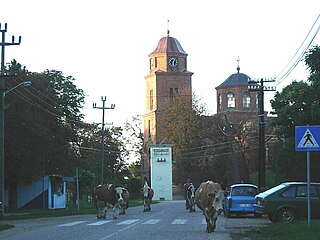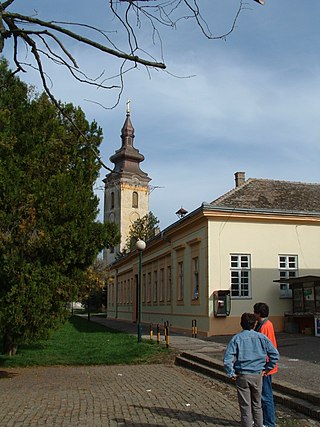
Alibunar is a town and municipality located in the South Banat District of the autonomous province of Vojvodina, Serbia. Alibunar town and Alibunar municipality have a population of 2,883 and 19,780 respectively.

Pećinci is a village and municipality located in the Srem District of the autonomous province of Vojvodina, Serbia. The village has a population of 2,581 (2011), while Pećinci municipality has 19,720 inhabitants.

Čalma is a village located in the Sremska Mitrovica municipality, in the Syrmia District of Vojvodina, Serbia. It is situated in the autonomous province of Vojvodina. The village has a Serb ethnic majority and its population numbering 1,675 people.
Filić is a village located in the Novi Kneževac municipality, in the North Banat District of Serbia. It is situated in the Autonomous Province of Vojvodina. The village has a Serb ethnic majority (60.24%) with a significant Hungarian minority (38.50%). It has a population of 161 people.

Veliko Središte is a village in Serbia. It is situated in the Vršac municipality, in the South Banat District, Vojvodina province.

Dobrica is a village in Serbia. It is situated in the Alibunar municipality, in the South Banat District, Vojvodina province. The village has a Serb ethnic majority and a population of 1,344 people according to the 2002 census.

Čortanovci is a village located in the Inđija municipality, Srem District, Vojvodina province, Serbia. It As of 2011 census results, the village has a population of 2,337 inhabitants.

Martinci is a village in Serbia. It is situated in the Sremska Mitrovica municipality, Srem District, Vojvodina province. The village has a Serb ethnic majority and its population numbering 3,639 people.

Miletićevo is a village located in the Plandište municipality, in the South Banat District, Vojvodina, Serbia. As of 2011, the village has a population of 497 inhabitants.

Šašinci is a village in Serbia. It is located in the Sremska Mitrovica municipality, in the Srem District, Vojvodina province. The village has a Serb ethnic majority and its population numbering 1,830 people.

Donji Petrovci is a village in Serbia. It is situated in Ruma municipality, Srem District, Vojvodina province. The village has a Serb ethnic majority and a population of 991 people. There is a significant ancient Roman archaeological site near the village - the remains of large city Bassianae, which in the 3rd century had the highest status of colonia.

Malo Bavanište is a village in Serbia. It is situated in the Kovin municipality, South Banat District, Vojvodina province. The village has a Serb ethnic majority (94.28%) and its population numbering 420 people.

Baranda is a village in Serbia. It is situated in the Opovo municipality, South Banat District, Vojvodina province. The village has a Serb ethnic majority (93.56%) and its population numbering 1,550 people. The village was a center point of the popular television series "Vratiće se rode".

Markovićevo is a village in Serbia. It is situated in the Plandište municipality, South Banat District, Vojvodina province.

Ogar is a village in Serbia. It is situated in the Pećinci municipality, in the Srem District, Vojvodina province. The village has a Serb ethnic majority and its population numbering 1,143 people.

Prhovo is a village in Serbia. It is in Pećinci municipality of the Srem District in Vojvodina province. The village has a Serb ethnic majority and its population was 708 as of the 2022 census.

Krnješevci is a village in Serbia. It is situated in the Stara Pazova municipality, in the Srem District, Vojvodina province. The village has a Serb ethnic majority and its population numbering 1,025 people.

Klenak is a village in Serbia. It is situated in the Ruma municipality, in the Srem District, Vojvodina province. The village has a Serb ethnic majority and its population numbering 3,246 people. The village also has its own football club FK Borac Klenak.
Below is a list of Romanian language exonyms for towns and villages in the Vojvodina region of Serbia.

The Vatin culture is a name of a prehistoric Bronze Age culture, which was named after Vatin, a village in Serbia. The culture had Indo-European roots and was culturally connected with Mycenaean Greece. The Vatin culture is dated to the middle Bronze Age and is generally divided into three phases: Pančevo-Omoljica, Vatin-Vršac, and Belegiš-Ilandža. It flourished from c. 2000 BC to 1500 BC, or until the 13th century BC according to some sources.





















